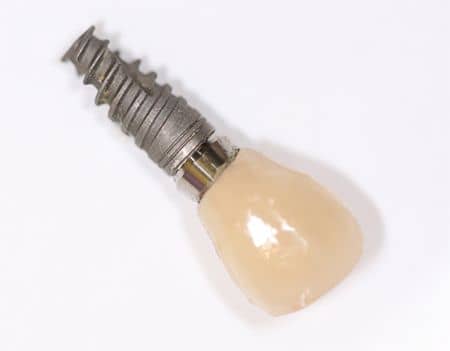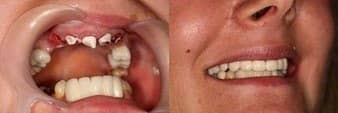A dental implant is an artificial tooth root placed in the maxillary or mandible to support a crown, bridge or denture, to replace one or more missing teeth.

It is the optimal solution in restoring missing teeth and has several shapes, but the most commonly used is in the form of a screw.
The main advantage is the preservation of the neighboring teeth, so by avoiding their preparation they remain intact.
Another equally important advantage is that once restored the functionality of the area by facilitating the mastication, the atrophy of the bone disappears, maintaining it's height and thickness over time.
The implants have a much longer life than other prosthetic restoration methods, so it is an investment in the future.

The ideal candidates for receiving dental implants are the healthy patients, free of any chronic diseases, with a good performance status and oral hygiene.
It takes a proper bone density to support the implant, so the best patients are those with healthy gums free of periodontal disease. To determine the exact quality and quantity of the bone preoperative tomographic analysis is recommended.
There are absolute contraindications, such as patients with heart disease, hepatitis, bruxism (diurnal or nocturnal) and relative contraindications such as diabetes where the medication taken keeps blood sugar under control and the patient is able to receive an implant.
The specialist is the one who will answer this question after the consultation.
The number of the dental implants required is always set by the dentist after consultation. Ideally, the number of implants must be equal to the lost teeth, but often insufficient bone does not allow the insertion of all implants required.

Many times, in the case of extended edentation (latero-lateral, frontal or even total), we insert fewer implants than the number of missing teeth, and the prosthetic solution is that using dental bridges. We never use prosthetic joint over implant and natural teeth, because it leads in time to the loss of the implant.
Under anesthesia, the implantologist creates a neoalveola with the same size as the future implant, calculated in advance depending on the width and height of bone, then the implant is inserted and the gums sutured.
A period of osseointegration and implant acceptance by the body follows (the bone starts growing around the implant). Postoperative pain is minimal, because there is no infection that may exist in the case of extractions or apical resection.
The recovery period is different for each patient and determined after the surgery.

Prosthetic restoration of the implants may be immediate or late. The most common and safest way is the late restoration, after an interval of 2-6 months, during which time the patient may use a temporary prosthetic device. Immediate prosthesis is only used in special cases because the risk of rejecting the newly inserted implant is higher.
The risk of rejecting a dental implant always exists, but it happens extremely rarely and to a very small percentage of patients.
In most cases, it is associated with general diseases that contraindicate surgical maneuvers in general. Smoking increases the risk of rejection of dental implants, but it is directly proportional to the number of cigarettes smoked per day and the number of years since the patient is a smoker.
No, or if there is, it is minimum. The insertion operation and postoperative recovery are always done under the protection of antibiotics. If you want to learn more about postoperative care, click on Dental Implant - Post-Op.
To find out the price for a dental implant go to our Pricelist page.



To see more of our patients please visit Clinical Cases
For more information and an appointment made by a dental implant specialist we welcome you to our clinic.
Last updated: November 10th, 2018